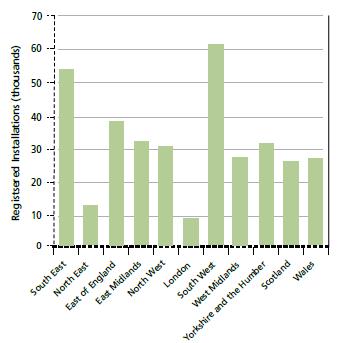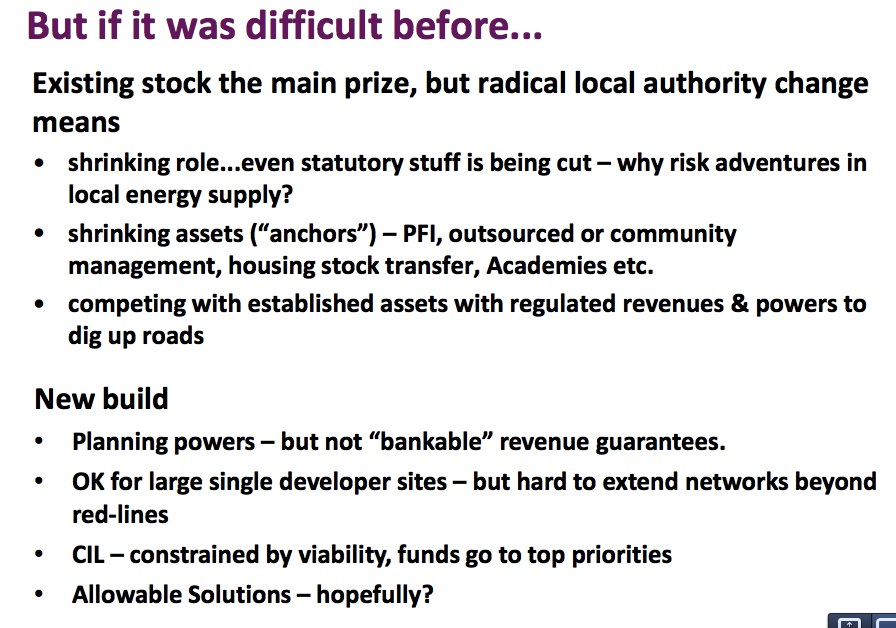Site search:
-
What’s new?
Energy for London Tags
Brent Buildings Camden Carbon Emissions CHP Cities Climate Adaptation Community Heating Community Initiatives Croydon Data DECC Decentralised Energy Distribution ECO Energy Costs Energy Efficiency Enfield FIT Fuel Poverty Funding Green Deal Hackney Haringey Housing Islington Lambeth Library Local Authorities Mayor Newham Ofgem Olympics Photovoltaics Planning RE:FIT RE:NEW Renewable Energy Retrofit Southwark Tower Hamlets Transport Waltham Forest Waste WestminsterEnergy Archives:
- February 2021 (1)
- January 2021 (15)
- December 2020 (15)
- November 2020 (9)
- October 2020 (3)
- August 2020 (5)
- July 2020 (3)
- June 2020 (4)
- April 2020 (10)
- March 2020 (5)
- February 2020 (2)
- January 2020 (3)
- October 2019 (1)
- September 2019 (4)
- August 2019 (2)
- July 2019 (1)
- August 2018 (1)
- November 2016 (8)
- October 2016 (8)
- September 2016 (2)
- August 2016 (8)
- July 2016 (14)
- April 2016 (12)
- March 2016 (16)
- February 2016 (8)
- January 2016 (4)
- December 2015 (1)
- November 2015 (1)
- October 2015 (16)
- September 2015 (3)
- June 2015 (1)
- May 2015 (1)
- April 2015 (1)
- March 2015 (1)
- February 2015 (1)
- January 2015 (1)
- December 2014 (18)
- November 2014 (4)
- August 2014 (8)
- July 2014 (7)
- June 2014 (25)
- May 2014 (8)
- April 2014 (4)
- March 2014 (12)
- February 2014 (7)
- January 2014 (13)
- December 2013 (11)
- November 2013 (15)
- October 2013 (15)
- September 2013 (18)
- August 2013 (5)
- July 2013 (20)
- June 2013 (33)
- May 2013 (8)
- April 2013 (16)
- March 2013 (25)
- February 2013 (14)
- January 2013 (20)
- December 2012 (23)
- November 2012 (23)
- October 2012 (25)
- September 2012 (14)
- July 2012 (12)
- June 2012 (43)
- May 2012 (20)
- April 2012 (8)
- March 2012 (40)
- February 2012 (39)
- January 2012 (40)
- December 2011 (22)
- November 2011 (40)
- October 2011 (33)
- September 2011 (48)
- August 2011 (40)
- July 2011 (58)
- June 2011 (41)
- May 2011 (80)
- April 2011 (38)
- March 2011 (33)
- February 2011 (25)
- January 2011 (24)
- December 2010 (3)
- November 2010 (7)
- October 2010 (6)
- September 2010 (7)
- August 2010 (1)
- July 2010 (2)
- June 2010 (4)
- May 2010 (1)
- March 2010 (3)
- February 2010 (3)
- December 2009 (5)
- November 2009 (2)
- October 2009 (3)
- July 2009 (3)
- June 2009 (1)
- April 2009 (1)
- March 2009 (1)
- February 2009 (1)
- January 2009 (1)
- December 2008 (2)
- October 2008 (1)
- September 2008 (1)
- July 2008 (1)
- March 2008 (2)
- January 2008 (2)
- October 2007 (1)
- September 2007 (3)
- July 2007 (1)
- March 2007 (1)
- February 2007 (3)
- November 2006 (3)
- August 2006 (1)
- February 2006 (1)
- May 2005 (1)
- February 2004 (1)
Author Archives: Admin
Energietübbing for Crossrail?
 April 2013: This week’s New Scientist features how “Smart heat is helping building the next energy revolution”. The article (subscription only…) looks how the use of technologies such as combined heat and power (CHP) and heat pumps could help “reverse some of the damaging effects that waste heat from our towns and cities is having on the climate ” – and the use of waste heat from London Underground is also examined:
April 2013: This week’s New Scientist features how “Smart heat is helping building the next energy revolution”. The article (subscription only…) looks how the use of technologies such as combined heat and power (CHP) and heat pumps could help “reverse some of the damaging effects that waste heat from our towns and cities is having on the climate ” – and the use of waste heat from London Underground is also examined:
“As passengers often complain, exhaust heat accumulates in the train tunnels under many of our largest cities. Even on a cold day, temperatures on platforms in the London Underground can reach 20 °C. To harvest that warmth, German companies Züblin and Rehau, together with Arup, have designed a liner for tunnel segments that functions like the buried coils in ground source heat pumps, using the heat generated by engines and braking along with that from the surrounding ground to warm the refrigerant, again by compression. As this transfers the excess energy from the tunnel to the refrigerant, the process also causes the tunnel to cool.”
“The lining – dubbed Energietübbing – was placed into a 54-metre-long stretch of a new high-speed rail tunnel in Jenbach, Austria, to supply the municipal building above with enough heat to completely replace the existing boiler. It is still being optimised, but in its first successful winter it coped with outside temperatures as low as -15 °C. London commuters could soon benefit as well. Crossrail, a railway being constructed under the city, is considering Energietübbing for several segments of the new tunnel, where it too would both cool the tunnel and provide the resulting heat to buildings above.”
A recent question to the Mayor highlights which of the stations on the Crossrail route are planned to integrate heat pump technology to provide waste heat to buildings above. “Out of the twelve oversite development schemes Crossrail is developing only two will not include a capability for using ground source heat pumps. These are at Woolwich and Limmo, where Crossrail is constructing a vent shaft. At these sites a large proportion of the oversite development schemes are not integrated with Crossrail infrastructure. Future owners of these oversite development schemes will however be able to install ground source heat pump technology within the buildings foundations. “
A Haringey Green Deal Diary
April 2013: Great blog of a Green Deal ‘journey’ by sustainability expert Sofie Pelsmakers. Sofie started the process with a free Green Deal energy assessment offered to residents and business in Haringey (which is funded through DECC’s recently Green Deal Pioneer Places funding). These free assessments are still on offer with the deadline recently extended to 30 April – more here.
Having had her assessment finalised – Sofie appears now to be struggling to secure Green Finance:
 DECC issued their latest Green Deal and ECO monthly statistics last week with Greg Barker stating that “It is clearly very early days but the latest figures on the Green Deal show that this new market is gathering real momentum. 9,268 Green Deal assessments taking place in just over two months is very encouraging and shows a genuine interest from consumers.”
DECC issued their latest Green Deal and ECO monthly statistics last week with Greg Barker stating that “It is clearly very early days but the latest figures on the Green Deal show that this new market is gathering real momentum. 9,268 Green Deal assessments taking place in just over two months is very encouraging and shows a genuine interest from consumers.”
The statistics do not however provide a breakdown of how many of these assessments came out of activities through the Energy Company Obligation (ECO) process rather than directly as a result of households taking up the Green Deal. Additionally, the Green Deal Finance Company have stated that it is “yet to sign its first Green Deal Plan with a householder, but suggested it would not be long before it did. “There is one good to go and we are reviewing two others””.
Green Deal statistics for London will be available from DECC in June.
Mayor warms to solar
15 April 2013: The Mayor tweeting from a visit to Dubai: “Fascinating visit to @MasdarCity; a new city entirely powered by solar energy”
Greenwich Peninsula DE network
April 2013: Industry journal Utility Week revealed last week that E.ON is planning to support the development of a district heating development in the Greenwich Peninsula. The brief story states that “The energy company is in talks with the Royal Borough of Greenwich to develop heat networks around the O2 Arena”.
E.ON’s website provides some further detail on their role to date: “Initially E.ON undertook a high level technical model of the Greenwich Peninsula to assess and validate both heat demand and the indicative heat network design. A design audit shortly followed. E.ON is advising the Greenwich Peninsula Regeneration venture on the heat network design and specification provided by other consultancies, ensuring it’s sufficiently robust to be adopted by an ESCo (Energy Services Company).”
The March 2012 Greenwich Heat Mapping Study provides much more information, setting out that the “Greenwich Peninsula cluster focuses on the existing district heating network at the Greenwich Millennium Village and the O2 Stadium site and the proposed district heating network for the Greenwich Peninsula Regeneration Limited (GPRL) site. The new redevelopment site consists of 10,000 new homes and 340,000 square meters of mixed use space.”
The study goes on to say that a wider area heat network could in fact be developed by “engaging with the developers for Heart of East Greenwich, Lovell’s Wharf and Enderby Wharf to gain clarity on progress and potential for linking to wider DE network”.
Greenwich’s Climate Change Strategy from 2011 sets out plans for the wider use of decentralised energy across the borough. Greenwich’s Core Strategy consultation also sets out plans for supporting the development of CHP.
Posted in Decentralised Energy, News
Tagged CHP, Community Heating, Decentralised Energy, Greenwich
Leave a comment
London CRC Performance
April 2013: The Carbon Reduction Commitment (CRC) Performance Table was published a few weeks ago and attracted some media attention on who had gone up and down the table (see Guardian article here). The CRC is a complex mechanism and Government has had to return to tweak the policy time and again to simplify it. Along with the performance table, it appears the Chancellor’s view of simplification is, as set out in his Autumn Statement (December 2012), to get rid of the CRC altogether.
“1.127 The CRC’s Performance League Table will be abolished, to simplify the scheme further. A full review of the effectiveness of the CRC will be held in 2016 and the tax will be a high priority for removal when the public finances allow.”
For those new to the CRC, they should be made aware the original plan of the policy was to recycle the funds obtained from participants purchase of carbon permits, into sector-wide energy efficiency funding. The incoming Government however changed plans in 2010 and the Chancellor simply took all the funds into Government. It’s more than likely the Government would like to see the back of the CRC sooner, however, it does bring in close to £1bn to the Exchequer a year and this will increase again, as the 2012 Autumn Budget highlights: “2.88 The forecast allowance price remains unchanged at £12 per tonne of carbon dioxide in 2013-14 and £16 per tonne of carbon dioxide in 2014-15. From 2015-16 onwards, the allowance price will increase in line with the RPI.”
Back to the performance table: how did London do?
Disabled Facilities Grant to fund heating
April 2013: The Department for Communities and Local Government announced last week new funding to help councils fund the adaptations disabled people need to live independently in their own home. The press release states that “Ministers have protected the Disabled Facilities Grant programme for the last 3 years, with a further £185 million expected in next year’s funding“.
Included in eligible types of work for funding are:
- adapting heating or lighting controls to make them easier to use
- improving or providing a suitable heating system
A document setting out the allocation awarded to each local authority is provided here. Looking at London councils , it can be seen a total of £23.5m has gone to the capital – a breakdown of each borough’s funding is provided below:
Decarbonising London’s electricity network
March 2013: An update on progress of the Low Carbon London programme as it moves into the trial phase – the key areas for which are:
- Smart metering (SM) – monitoring residential and commercial electricity use and trialling variable tariff pricing to shift consumption behaviour.
- Small-scale embedded generation (SSEG) – quantify generation output, understand demand and manage techniques for accommodating these connections.
- Electric vehicles (EV) – understand and influence EV charging patterns and manage the impact on the electricity network.
- Distributed energy (DE)/Distributed generation (DG) – active network monitoring (ANM) – quantify generation output, understand how to facilitate and manage DG and how active control can be used by DNOs.
- Demand response (DR) – understand the potential to postpone/defer electricity network reinforcement during peak demand.
Further information on Low Carbon London here.
4MW of PV added in London
March 2013: Ofgem’s new FIT quarterly report provides an update on the take-up of Feed in Tariff eligible technologies across the UK. London (as at 31 December 2012) has a total of 39.38 MW of FIT renewable capacity installed – as with the rest of the country, the vast proportion of this capacity is made up of PV (99% in London). This is an increase of 4.25 MW of capacity over the previous quarter.
Progress remains slow in London which – with the North East – trails all other UK regions by a significant margin. See graph from FIT report below highlighting the number of installations by region.
 Previous posts discuss London’s slow performance on FIT take up here.
Previous posts discuss London’s slow performance on FIT take up here.
The Future of Heating in London
March 2013: The Government’s Future of Heating policy paper released yesterday gives prominent coverage to activities underway in London to promote the use of decentralised energy systems through the use of district heating and high efficiency Combined Heat and Power (CHP) systems. The paper includes the following:
- A case study of The Shard CHP heat network [p41]
- How Islington Council, the GLA and UK Power Networks are working together on “a proposed extension of the existing Bunhill heat network that will capture and use identified sources of waste heat produced within the area, such as from a nearby electricity sub-station. This project will help London and its boroughs to identify, capture and make use of urban sources of waste heat and play an important part in developing their lower carbon, lower temperature heat networks ofthe future” [p43] Continue reading…
Posted in Library, News
Leave a comment
Getting into Hot Water…
March 2013: Presentation made at the the recent Combined Heat and Power Association (CHPA) district heating conference, by Bob Fiddik, Sustainable Development & Energy Team Leader at Croydon Council, giving some valuable insights into the challenges faced when developing heat networks. The presentation includes:
- Some of the history behind the failure of the SELCHP energy from waste plant to develop the expected district heat network anticipated when it was built – and the recent work now being undertaken to help turn this around
- The unhappy circumstances that led to the stalling of the hugely exciting Elephant & Castle heat network project, and
- An update to the major district heating scheme currently being planned for Croydon.
Slide 14 of the presentation sets out – as challenging as circumstances have been in the past – things are not unfortunately getting easier:
 Download ‘Getting into hot water…not always that easy’ here.
Download ‘Getting into hot water…not always that easy’ here.
Posted in News
Tagged Community Heating, Croydon, Decentralised Energy, SELCHP, Southwark
Leave a comment
Threefold increase in fuel poverty in London over past decade
27 March 2013: A parliamentary question asking about the numbers of fuel poor households in the UK, including for numbers at the regional level, helps provide an indication about the growth in fuel poverty in the capital over the past decade.
Data is only available as yet to 2010 (see PQ link above for references): updated statistics for 2011 and 2012 will be made available in June of this year. London is common with most other areas in observing a threefold increase in the numbers of fuel poor households as a consequence of increasing fuel prices – most notably from 2005/06 onwards. The Government is however currently working on a redefining the definition of fuel poverty and the proposals – as set out out in a consultation paper late last year – are anticipated to have a significant impact in London, as a consequence of housing costs now being taken into consideration (see earlier post here for details).
The Big London Energy Switch
March 2013: The ‘Big London Energy Switch’ collective switching scheme was initiated earlier this year after securing £686,655 in funding from DECC (see earlier post here for full details). Those involved include London Councils, with 18 other boroughs and with the Royal Borough of Kingston as lead. Kingston is also where Secretary of State for Energy, Ed Davey, a longtime support of collective purchasing, is the local MP (see here for further details). The other 17 London boroughs are: Bexley, Brent, Camden, Croydon, Ealing, Enfield, Greenwich, Hackney, Haringey, Islington, Lambeth, Merton, Newham, Richmond, Southwark, Sutton and Waltham Forest.
A recent London Councils briefing paper highlights that three other boroughs (Lewisham, Harrow and Tower Hamlets) are now also supporting the scheme but are not in receipt of DECC funding. A Big London Energy Switch website has now been established along with an introductory video to the initiative.
The Scheme is currently procuring a switching provider with support from law firm Pinsent and Masons.




